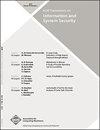Group-Centric Secure Information-Sharing Models for Isolated Groups
Q Engineering
ACM Transactions on Information and System Security
Pub Date : 2011-11-01
DOI:10.1145/2043621.2043623
引用次数: 34
Abstract
Group-Centric Secure Information Sharing (g-SIS) envisions bringing users and objects together in a group to facilitate agile sharing of information brought in from external sources as well as creation of new information within the group. We expect g-SIS to be orthogonal and complementary to authorization systems deployed within participating organizations. The metaphors “secure meeting room” and “subscription service” characterize the g-SIS approach. The focus of this article is on developing the foundations of isolated g-SIS models. Groups are isolated in the sense that membership of a user or an object in a group does not affect their authorizations in other groups. Present contributions include the following: formal specification of core properties that at once help to characterize the family of g-SIS models and provide a “sanity check” for full policy specifications; informal discussion of policy design decisions that differentiate g-SIS policies from one another with respect to the authorization semantics of group operations; formalization and verification of a specific member of the family of g-SIS models; demonstration that the core properties are logically consistent and mutually independent; and identification of several directions for future extensions. The formalized specification is highly abstract. Besides certain well-formedness requirements that specify, for instance, a user cannot leave a group unless she is a member, it constrains only whether user-level read and write operations are authorized and it does so solely in terms of the history of group operations; join and leave for users and add, create, and remove for objects. This makes temporal logic one of the few formalisms in which the specification can be clearly and concisely expressed. The specification serves as a reference point that is the first step in deriving authorization-system component specifications from which a programmer with little security expertise could implement a high-assurance enforcement system for the specified policy.孤立组的以组为中心的安全信息共享模型
以组为中心的安全信息共享(g-SIS)设想将用户和对象聚集在一个组中,以促进从外部来源引入的信息的敏捷共享以及在组内创建新信息。我们期望g-SIS与参与组织内部署的授权系统是正交和互补的。“安全会议室”和“订阅服务”是g-SIS方法的特征。本文的重点是开发孤立g-SIS模型的基础。组是隔离的,因为组中的用户或对象的成员身份不会影响它们在其他组中的授权。目前的贡献包括以下内容:核心属性的正式规范,可以立即帮助描述g-SIS模型族,并为完整的策略规范提供“完整性检查”;对策略设计决策的非正式讨论,这些决策根据组操作的授权语义区分g-SIS策略;g-SIS模型家族中特定成员的形式化和验证;证明核心属性在逻辑上是一致且相互独立的;并确定了未来扩展的几个方向。形式化的规范是高度抽象的。除了某些格式良好的要求,例如,用户不能离开组,除非她是组的成员,它只限制用户级别的读写操作是否被授权,并且它完全根据组操作的历史来进行;用户的连接和离开,对象的添加、创建和删除。这使得时间逻辑成为能够清晰而简洁地表达规范的少数形式之一。该规范用作参考点,它是派生授权系统组件规范的第一步,稍有安全专业知识的程序员可以从中为指定的策略实现高保证的实施系统。
本文章由计算机程序翻译,如有差异,请以英文原文为准。
求助全文
约1分钟内获得全文
求助全文
来源期刊

ACM Transactions on Information and System Security
工程技术-计算机:信息系统
CiteScore
4.50
自引率
0.00%
发文量
0
审稿时长
3.3 months
期刊介绍:
ISSEC is a scholarly, scientific journal that publishes original research papers in all areas of information and system security, including technologies, systems, applications, and policies.
 求助内容:
求助内容: 应助结果提醒方式:
应助结果提醒方式:


